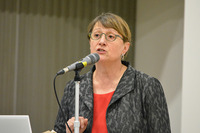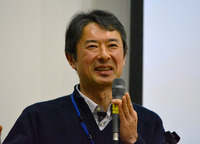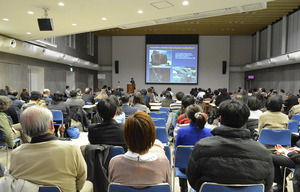Event Report
Public Lecture "Life in the Universe"
One of the highlights of the 2015 ELSI Symposium was sharing ELSI science with our local community. At the end of the 1st day we arranged 2 talks, one in English and one in Japanese with simultaneous interpretation. Dr. Mary Voytek, Director of the NASA Astrobiology program, and Dr. Shigeru Ida, ELSI Principal Investigator, offered the audience insight into research contributing to our understanding of "Life in the Universe".
How do we look for life beyond Earth? Dr. Voytek began by describing her initial work in aquatic microbial ecology which gave rise to her interest in life in extreme environments. She gave a vivid overview of the many types of extreme environments that currently exist on the Earth and their possible relation to environments on other objects in our solar system and beyond. The environments include those that are at high/low temperature, high pressure, in deep water, and without water; as well as those with high salinity, high/low acidity, and those not based on solar energy. It is amazing to see how life has adapted to Earth's harshest environments, and does lead one to wonder what might be possible in our vast universe.
Dr. Voytek began by describing her initial work in aquatic microbial ecology which gave rise to her interest in life in extreme environments. She gave a vivid overview of the many types of extreme environments that currently exist on the Earth and their possible relation to environments on other objects in our solar system and beyond. The environments include those that are at high/low temperature, high pressure, in deep water, and without water; as well as those with high salinity, high/low acidity, and those not based on solar energy. It is amazing to see how life has adapted to Earth's harshest environments, and does lead one to wonder what might be possible in our vast universe.
Clues from the Moon for understanding the Earth and its life's origins  Dr. Ida captured the audience's attention describing the many ways in which the moon's formation has made life on Earth possible. While many moons in our solar system were captured by their host planet, we believe that our moon formed by a violent collision of a Mars-sized body with the proto-Earth, creating the Earth-moon system that we know today. The impact melted the entire Earth which mixed the core leading to early magnetic field formation. The moon-forming event also set the stage for plate tectonics which appears vital for sustaining life. So when we gaze at the moon, we can appreciate not only its beauty, but also its role in setting the stage for life on Earth.
Dr. Ida captured the audience's attention describing the many ways in which the moon's formation has made life on Earth possible. While many moons in our solar system were captured by their host planet, we believe that our moon formed by a violent collision of a Mars-sized body with the proto-Earth, creating the Earth-moon system that we know today. The impact melted the entire Earth which mixed the core leading to early magnetic field formation. The moon-forming event also set the stage for plate tectonics which appears vital for sustaining life. So when we gaze at the moon, we can appreciate not only its beauty, but also its role in setting the stage for life on Earth.














